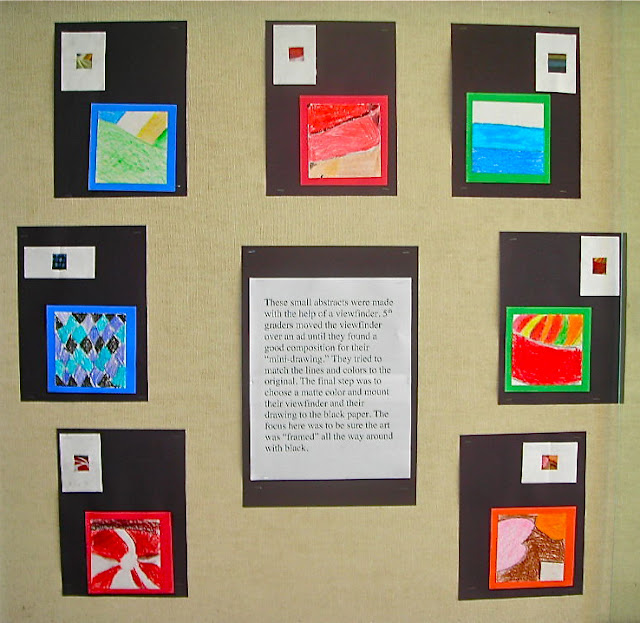 |
| Love the movement captured in this drawing!!! |
 |
| This student worked to carefully place color blocks accurately. |
 |
| What a nice example of shading in the white area! |
These were all completed in one class session (about 40 min. working time).
We started this project looking at a small "abstract" photo on the Smartboard, identifying properties (shapes, colors, shading, etc). Students then tried to find where this cropping came from in the larger photo.
I modeled how to make a viewfinder, mark the midpoints on the viewfinder and the 6" square of drawing paper to use as register marks and overlay crayon colors to blend exact hues. As it turned out, that is a whole other article that I'll post later.
 |
| You can see how this student shaded his reds with orange and black. |
I asked students to choose drawings that were non-representaional. This child turned his drawing sideways to create his abstract. These were actually 2 chicks -- but I love the way they look abstract at this angle. He actually worked very hard to capture shadows and texture that he observed.
I asked students to mount their drawings, first on a color of their choice, and then onto a 9" X 12" piece of black construction paper along with their viewfinder and magazine selection. Part of my lesson was teaching children about mounting their work leaving black showing on all sides of their mounted work. These kids are often asked to create posters or visual presentations in their regular classrooms, so this is another useful skill for them to have.
Aside from that, why do I like viewfinder exercises so much?? Well, first, I find that the small scale helps to train the eye for larger observational drawings. Second, color matching is an acquired skill that gets better and better with practice (as with anything, I guess!). And, finally, I LOVE how the results provide so many examples for discussion of composition, not to mention pattern, color, repetition, etc., etc........ I think, that if I taught in an upper elementary regular classroom, I would be doing these or variations of these once a month!!!



Nice. So did the students chose images that you had printed out or did they find images online and print them?
ReplyDeleteAhhhh -- I forgot to mention that!!! I gathered a stack of old catalogs that my mom was getting rid of and tore the pages apart (so they were loose, not stapled together) and put a stack at each table for kids to peruse. I did ask them to limit their choice to something that had a maximum of 3 colors in the interest of time.
DeleteReally nice. I used viewfinders a lot with still life's, but this is an original and wonderful idea. I had a student teacher who did a great viewfinder lesson for Georgia O'Keefe. The kids drew silk flowers from observation, then used a viewfinder to select an area and enlarge, and then repeated the process again to really zoom in on a small abstract detail. The were then redrawn on large watercolor paper, and painted, layering watercolor to create depth.
ReplyDeleteI used to use viewfinders with real objects, too, and I (and the kids) always had a hard time holding (or propping up) the viewfinder and drawing at the same time. This was much easier. I love that idea of zooming in twice -- the result was probably VERY abstract!!
ReplyDelete